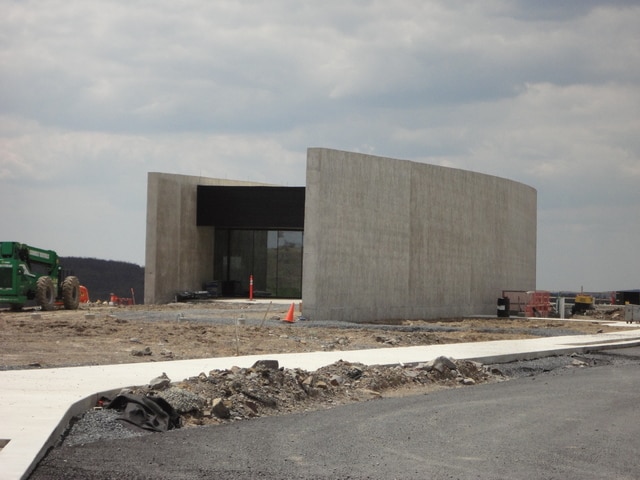
By Jane Beathard




SHANKSVILLE, Pa. — On a windswept knoll in the Laurel Highlands of south-central Pennsylvania, the National Park Service is creating a living tribute to 40 citizen heroes.
The Flight 93 National Memorial honors the United Airlines crew and passengers who fought their terrorist hijackers on 9/11. In the process, they likely saved the U.S. Capitol and hundreds of lives.
“A common field one day, a field of honor forever,” is the memorial’s theme.
Designed by Paul Murdoch Architects, construction of the memorial began in 2010 on 2,200 former strip-mined acres, largely acquired through purchase, donation and easement, according to Brendan Wilson, the park’s lead ranger.
A Memorial Plaza, encompassing the Wall of Names, was dedicated in 2011.
Work on the Visitor Center, walking path and 40 Memorial Groves were slated for completion by September 2015. Engineering is also under way for a Tower of Voices where visitors can hear many of the final recorded phone calls of Flight 93 passengers and crew, Wilson said.
More than 300,000 visitors now follow winding backroads to the memorial each year. They come from every state and many foreign countries, according to park ranger Wendy Clay.
A cell phone-directed walking tour tells them the story of 40 strangers, some from Japan, New Zealand and Germany, who boarded a United 757 airliner in Boston on the morning of Sept. 11, 2001 for a routine cross-country flight.
Forty-five minutes into the journey, they were herded to the rear of the plane by four hijackers. They called loved ones and learned of attacks in New York City and Washington, D.C.
Facing certain death, they took a vote to fight the terrorists who had commandeered the plane.
What happened in the next few moments was captured in vivid detail by a cockpit voice recorder. The rebelling passengers were breaching the cockpit door when a hijacker is overheard giving a final, fatal order.
“Pull it down,” he shouted.
As the plane flew low over the Pennsylvania hillsides at more than 500 mph, it rolled over and nosedived into the ground, killing everyone aboard. The time was 10:03 a.m. and the U.S. Capitol, where Congress had just convened for the fall, was spared.
First responders followed a tower of fire and smoke to the remote field. They found only a gaping crater and debris scattered in treetops and fields for miles around. Because the plane was fully loaded with 7,000 gallons of jet fuel, virtually all those aboard were incinerated instantly, Clay said.
The largest FBI investigation in history followed. Two thousand agents scoured the woods and fields for weeks. They dug 40 feet into the crash crater and recovered the plane’s black boxes. They also found documents that identified the hijackers and detailed plans for the 9/11 attacks, including information about those who coordinated and financed the plot, she added.
Once the investigation concluded, the crater was filled in. Today, only a simple sandstone boulder marks its former location.
Visitors are asked to maintain quiet and keep their distance from the boulder in respect for those who perished. Only survivors to the 40 passengers and crew are allowed to approach the field.
Temporary memorials to those who died went up immediately after 9/11 as neighbors and first responders sought to remember the heroism of those aboard United Flight 93, Wilson said.
Along the low, concrete walkway that leads to the Wall of Names, visitors leave memorabilia in niches designed for that purpose. In the last 14 years, park staff have collected and catalogued more than 60,000 mementos from those niches.
“We find all kinds of things — toys, coins, flags, T-shirts, baseballs, paper clips and sneakers,” Wilson said. “Sometimes, they even leave notes (to explain the significance).”
Some items were lost in an October 2014 fire at the memorial’s temporary headquarters. They included hundreds of photographs, recovered items and personal mementos of the victims donated for eventual display in the new Visitor Center.
Among the items saved from the flames were 35,800 comment cards left by visitors, photographs of the crash site and investigation, oral histories of families and first responders and three audio recordings of final phone calls made by passengers and crew members to their families, according to an NPS press release.
Forty Vermont marble panels, each eight feet high, make up the memorial’s Wall of Names. Each is engraved with the name of a Flight 93 passenger or crew member. The name of pilot Jason M. Dahl is there, as is the name of passenger Lauren Catizzi Grandcolas and her unborn child. Passenger Todd Beamer, whose “let’s roll” comment became a battle cry for retaliation, is also memorialized.
A quarter-inch gap separates each marble panel. But from a distance, they all appear as a solid wall. A park volunteer explained the design’s significance: the passengers were individuals who acted in unison to avert a greater disaster.
He also pointed out the memorial’s curvy layout, which follows the final flight path of the plane.
“It’s an open design that lets visitors find their own meanings,” Wilson explained. “Each visitor will have a vision of what it says.”
JANE BEATHARD
Jane is a retired staff writer for The Madison Press in London, and the retired media relations manager of the Ohio Department of Natural Resources.
ID, 'source', true); $sourcelink = get_post_meta($post->ID, 'sourcelink', true); $sourcestring = '' . __('SOURCE','gabfire') . ''; if ($sourcelink != '') { echo "
$sourcestring: $source
"; } elseif ($source != '') { echo "$sourcestring: $source
"; } // Display pagination $args = array( 'before' => '' . __('Pages:','gabfire'), 'after' => '
', 'link_before' => '', 'link_after' => '', 'next_or_number' => 'number', 'nextpagelink' => __('Next page', 'gabfire'), 'previouspagelink' => __('Previous page', 'gabfire'), 'pagelink' => '%', 'echo' => 1 ); wp_link_pages($args); // Display edit post link to site admin edit_post_link(__('Edit','gabfire'),'','
'); // Post Widget gab_dynamic_sidebar('PostWidget'); ?>